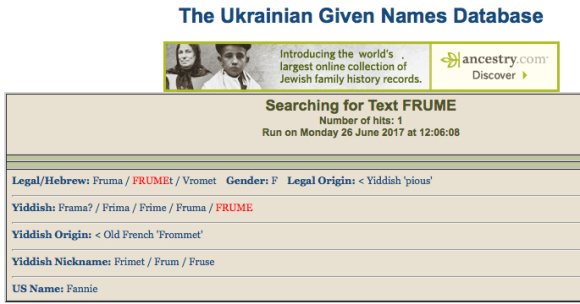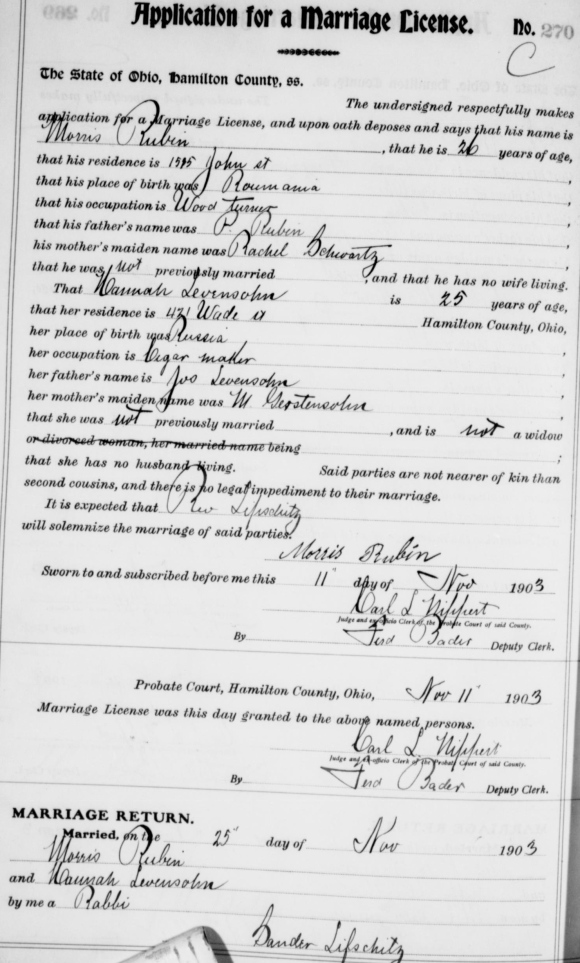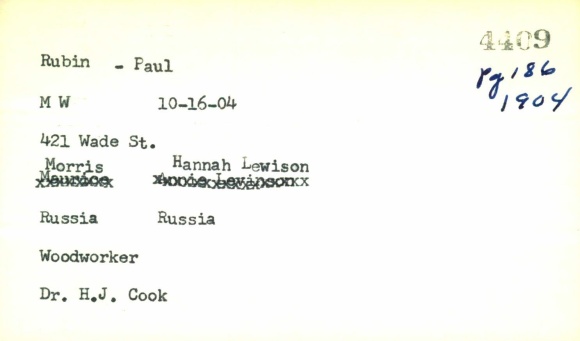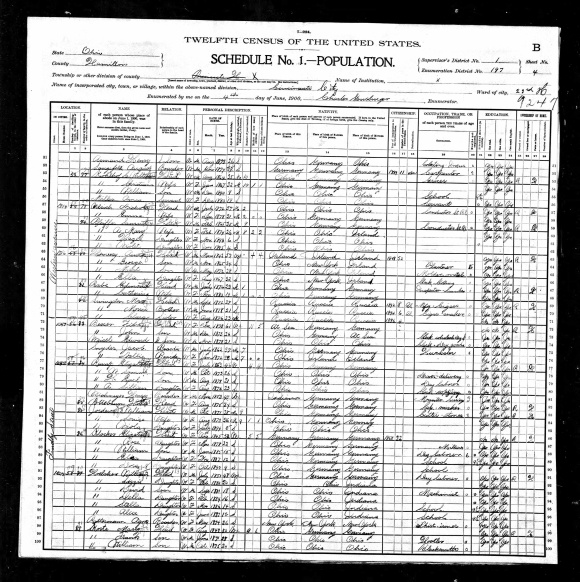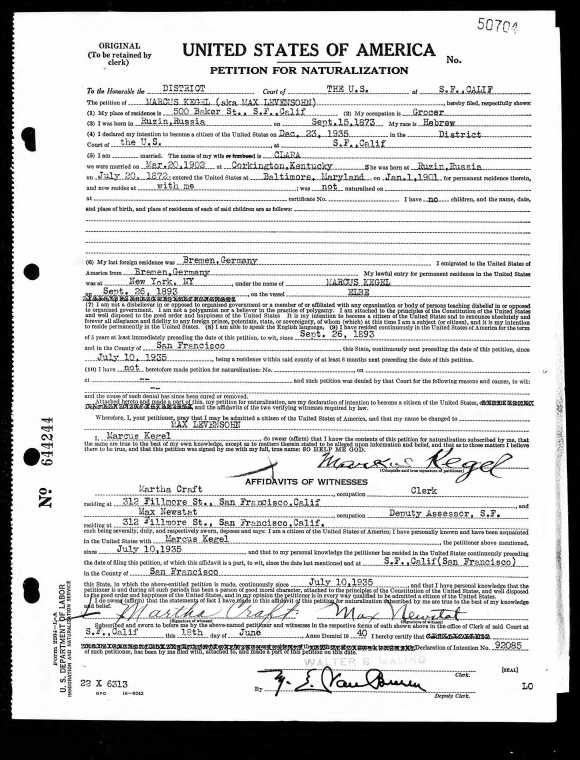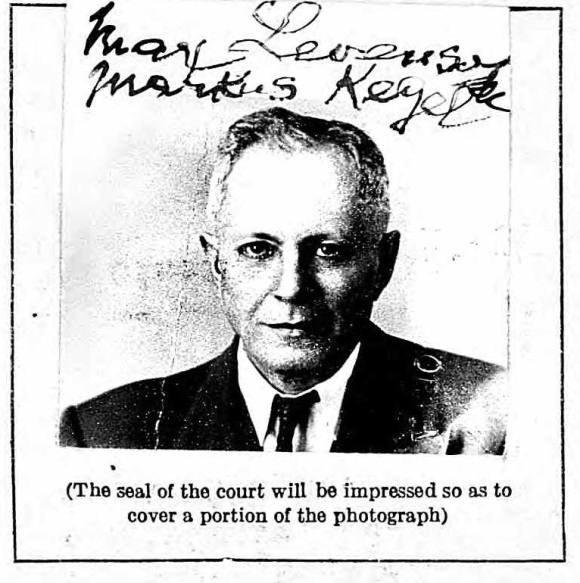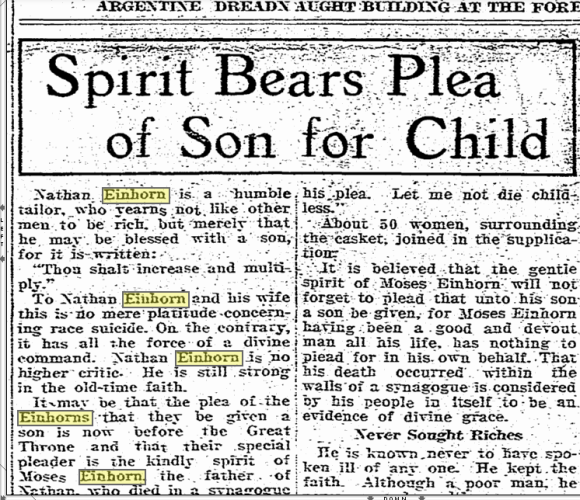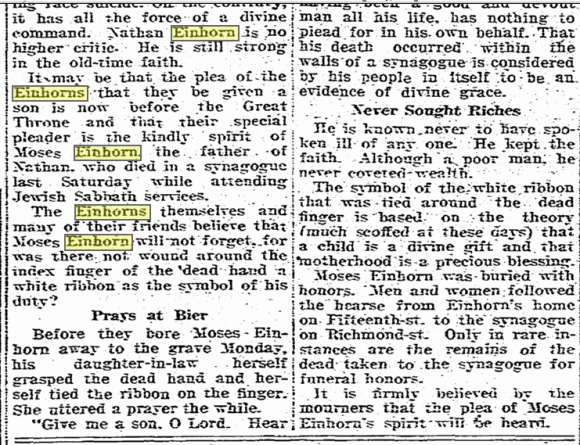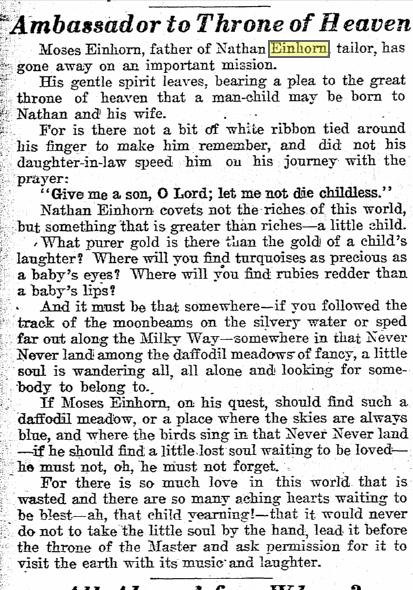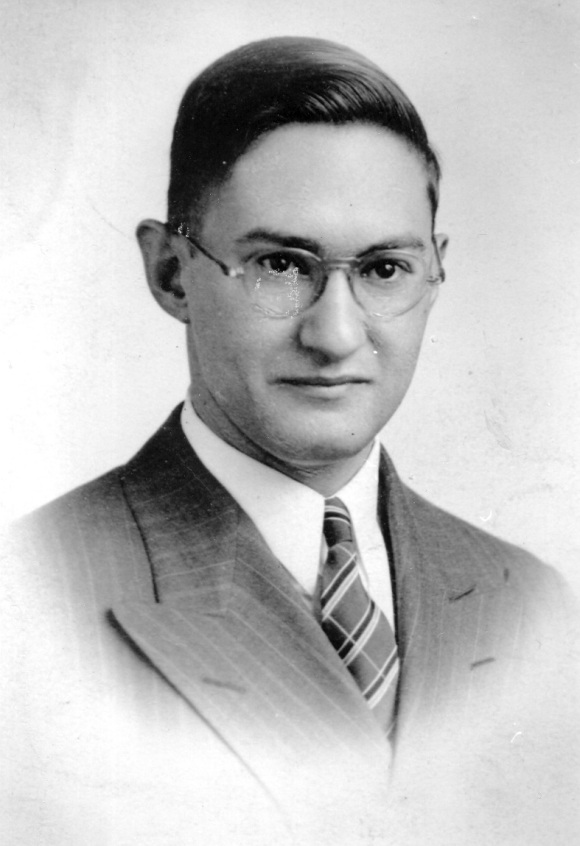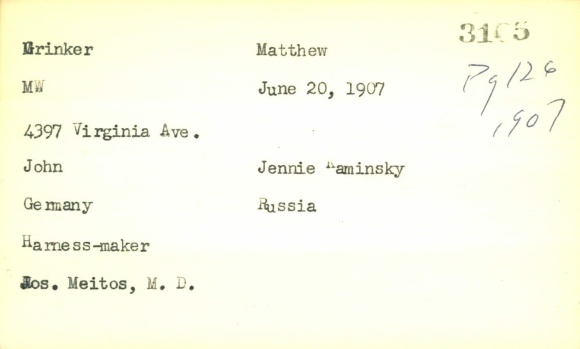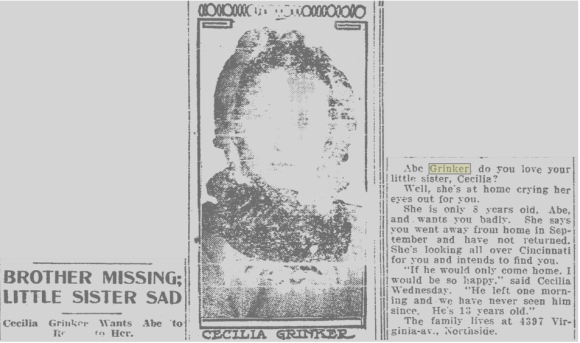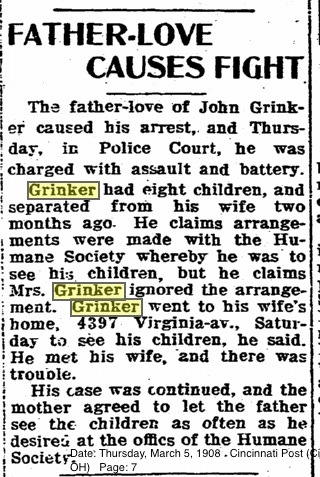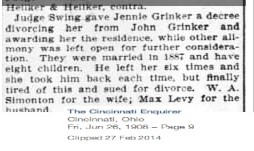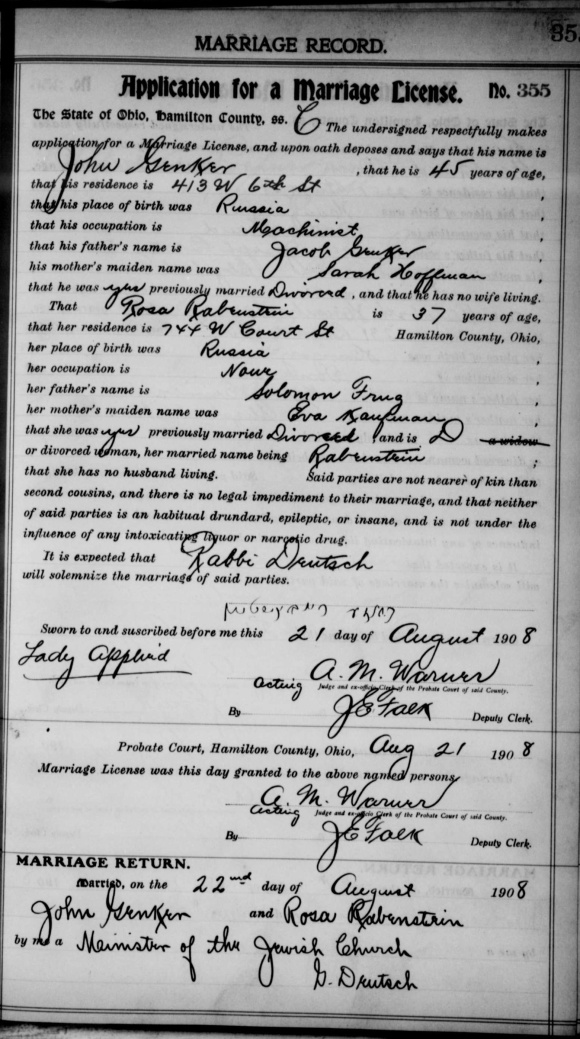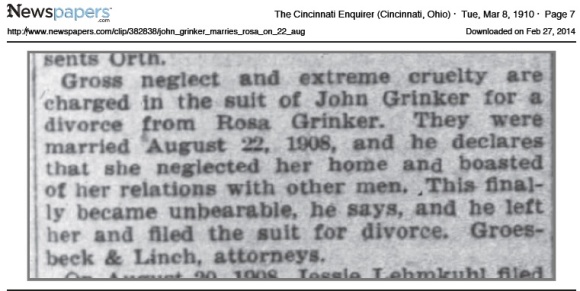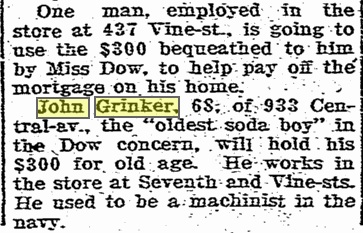The Forgotten Ancestors – Childless Women and Men
When I research my ancestors, I wonder who will remember those who left no descendents. The trails backward to female ancestors, especially, are often lost because they took their husbands’ surnames, and their birth surnames can’t be found in the records. But, when working the trails forward, finding cousins, there are no cousins descending from them. Who remains to remember them? I guess that will be me. As much as possible, I want to preserve the memories of these childless family members. I’ve already devoted a post to my paternal Aunt Dorothy Levensohn (http://wp.me/p35vsQ-3i). I hope to add others, both men and women. Today I want to devote a post to Sonia Einhorn, who was truly a family hero whose memory should be preserved.
Who She Was
I know little about who she was – even the bare bones of her biography. 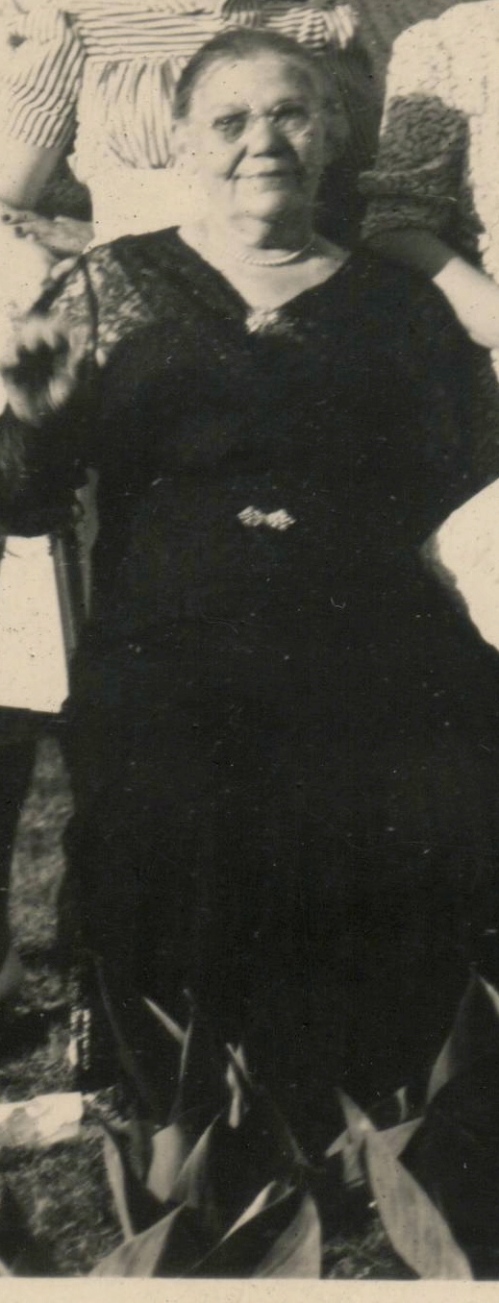 Sonia Einhorn was born Sarah Gertzman, in 1872, 1873 or 1874. Or maybe it was another year. She was born either in the town of Mogilev (now in Belarus) in the Russian Empire, or in the town of Senno (now Syanno) in the Mogilev Gubernia. Or, maybe – but probably not – she was born in Ekaterinoslav (now in Ukraine and called Dnipropetrovsk). Her father was Schlomo Gertzman, and her mother’s name is unknown to me. A guess is that her mother’s name was Liba, a name given as the wife of a Schlomo Gertzman, but not necessarily the same Schlomo Gertzman. Sonia had two brothers that I know about: Harry Gertzman and Nathan Gertzman. Nathan was one of my four great-grandfathers. (Of course, “Harry” and “Nathan” are Americanizations of their names. Their Yiddish and Hebrew names are variously transliterated.) Sonia married Nachum (Nathan) Einhorn, from Ekaterinoslav. She was already married and living in Ekaterinoslav in 1903 when she emigrated to the U.S. to meet her husband. So she was married some time before the age of 30.
Sonia Einhorn was born Sarah Gertzman, in 1872, 1873 or 1874. Or maybe it was another year. She was born either in the town of Mogilev (now in Belarus) in the Russian Empire, or in the town of Senno (now Syanno) in the Mogilev Gubernia. Or, maybe – but probably not – she was born in Ekaterinoslav (now in Ukraine and called Dnipropetrovsk). Her father was Schlomo Gertzman, and her mother’s name is unknown to me. A guess is that her mother’s name was Liba, a name given as the wife of a Schlomo Gertzman, but not necessarily the same Schlomo Gertzman. Sonia had two brothers that I know about: Harry Gertzman and Nathan Gertzman. Nathan was one of my four great-grandfathers. (Of course, “Harry” and “Nathan” are Americanizations of their names. Their Yiddish and Hebrew names are variously transliterated.) Sonia married Nachum (Nathan) Einhorn, from Ekaterinoslav. She was already married and living in Ekaterinoslav in 1903 when she emigrated to the U.S. to meet her husband. So she was married some time before the age of 30.
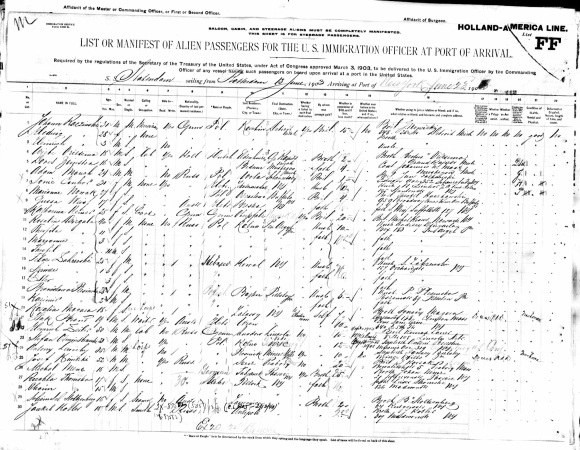
Sonia Einhorn arrives Ellis Island, 1903
If you are unable to decipher the manifest, here are the highlights: The sheet was for steerage passengers. The SS Statendam sailed from Rotterdam 13 June 1903, arrived NY on June 23. Sonia is on line 7, listed as “Sonie Einhor,” age 30 married, no occupation, able to read and write; country of last permanent residence – Russia; Hebrew race or people; last residence Yekaterinaslaw; final destination NY, passage paid by husband; carrying no money. She was to join her husband, “N Einhor ℅ A Finkelstein 105 Stanton St, NY.
Mogilev Woman, Ekaterinoslav Man
How did it happen that a Mogilev woman would marry an Ekaterinoslav man? Both towns were on the Dnieper River. The map below is one I found online, from an environmental project proposal (http://projects.inweh.unu.edu/inweh/display.php?ID=654), and it is the best I can find that shows the route from Mogilev to Ekaterinoslav (Dnipropetrovsk). I have not found out yet if the travel between the two places was via river or whether there was road or rail travel. 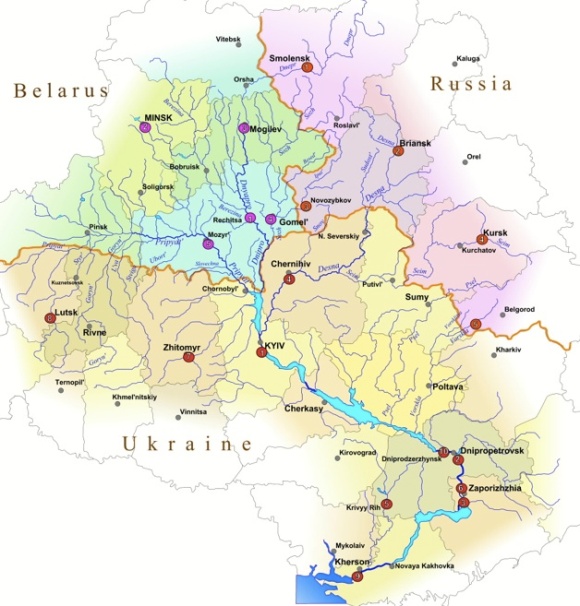 I believe both families, the Einhorns and the Gertzmans, were related. On passenger lists, both Einhorn and Gertzman men listed the same cousin – either a Finkelstein or a Shaffer – as their final destination upon arriving in New York. I still haven’t figured out how these Finkelsteins and Shaffers are our relatives, but they were apparently shared relatives with the Einhorns and Finkelsteins. Several Gertzman relatives gave Ekaterinolav as their hometown, or last residence; or told their descendents that it was their home town.
I believe both families, the Einhorns and the Gertzmans, were related. On passenger lists, both Einhorn and Gertzman men listed the same cousin – either a Finkelstein or a Shaffer – as their final destination upon arriving in New York. I still haven’t figured out how these Finkelsteins and Shaffers are our relatives, but they were apparently shared relatives with the Einhorns and Finkelsteins. Several Gertzman relatives gave Ekaterinolav as their hometown, or last residence; or told their descendents that it was their home town.
Lil’s story of the match
Lil Gertzman (her maiden name), my mother’s first cousin, was born in 1915 in Cincinnati. I was fortunate enough to make contact with her and speak with her, both on the phone (in 2001) and in person (in California in 2002). Lil knew her Great-Aunt Sonia well, visited her often in Lil’s childhood. Lil admired and was fond of Sonia. Although when I asked Lil about Sonia, Lil was showing some signs of occasional confusion, those old memories from Lil are the closest thing I have to a first-person account. According to Lil, Nachum (Nathan) Einhorn was the last boy left in his family and needed a match. The Einhorn family was unable to obtain a match with a dowry. Sonia’s family was poor, and there was no dowry, but she was bright and capable and literate. Lil did not know how the two families got together or were related.
A Quick Note About Names
Throughout this post I will use some names interchangeably: Nachum Einhorn = Nathan Einhorn; Sonia Einhorn = Sarah Einhorn. These names were used variously on records and in people’s conversations with me.
From Ellis Island to Cincinnati: 1903 – 1904
Women and children arriving at Ellis Island were routinely detained until they were fetched by a responsible man. In Sonia’s case she was gathered up almost immediately upon arrival by her husband, “Nathan Einhor” of 194 Allen St, NY City. The immigration service on Ellis Island needed only to feed her one meal, her evening dinner, before Nachum picked her up. The record is on line 15, below:
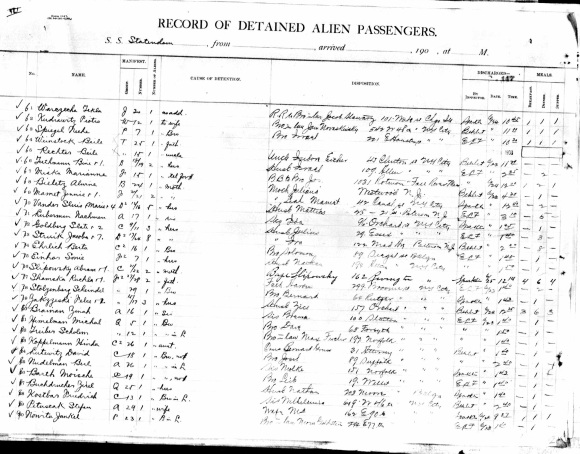
Record of Sonia Einhorn’s brief detention at Ellis Island
Sonia lived with Nachum in the Lower East Side of Manhattan for less than a year before they moved to Cincinnati.
Tenements on the Lower East Side
Jewish immigrants to New York in the early 20th century typically moved into tenements on the Lower East Side. Now there is a tenement museum (http://tenement.org), worth at least a day’s visit, including tenements re-created as they were when the immigrants lived there. The museum gives guided tours both of the tenement housing and of the Lower East Side. When Sonia sailed from Rotterdam to New York, the address she had for Nachum was the Finkelstein residence at 105 Stanton St. But when Nachum picked her up at Ellis Island his residence was 194 Allen St. Both of those addresses were tenements in the Lower East Side. The Einhorn address at the time they left, March 1904, was 231 E 10th St, a bit further north, in the East Village. Neither of the Lower East Side tenements exist today. The Stanton St. tenement has been replaced by an 8-apartment rental building built in 1995. The Allen St. address now is the location of the famous Katz Deli. The E 10th St building, however, was built in 1900 and is still standing: beautifully updated, it appears, and expensive to live in. The website Zillow.com estimates a one bedroom apartment here is valued at $1.6 million. Not too shabby.
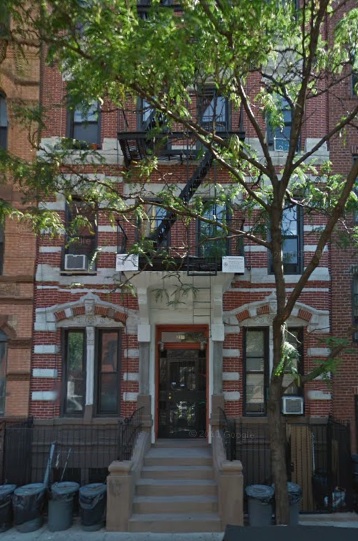
Sonia & Nachum’s last address, on E. 10th St., today.
I found this building in the 1910 Census. Then 87 people were living in this 5-storey building, or a little more than four people per 1-bedroom apartment.
Help from the Industrial Removal Office
The IRO was started in 1901 by the Jewish Agricultural Society, one of the Baron de Hirsch Fund projects. It attempted to resettle Jewish immigrants into interior U.S. communities, outside the New York City area. According to what I have read, it tried to find work for immigrants, then arrange for and finance transportation to those job opportunities. It looks to me as if Nachum and Sonia were not the first members of the extended family to be sent to Cincinnati by the IRO. In 1903 “Sal” (probably”Schmerl,” as the family knew him) Hertzman, a cabinetmaker, was sent to Cincinnati; and in January 1904 Abram Gertzman, a tailor, was sent. Both Schmerl and Abram (known to my mother’s generation as “Uncle Schmerl” and “Uncle Avrum”) were related to Sonia, possibly her first cousins. Maybe the existence of family already there was one reason Nachum and Sonia went to Cincinnati. Here is the record of the IRO sending Nachum and Sonia from NY City to Cincinnati, OH:
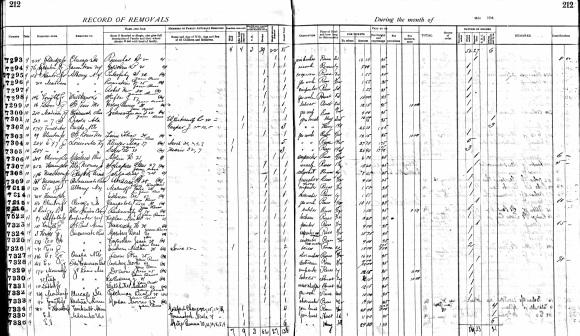
Nathan and Sonia Einhorn sent to Cincinnati March 1904 by the IRO
The IRO spent $18 on their tickets and $10.85 on their freight. Most people on the page received only 35 cents for freight, so the couple must have had considerable possessions, relatively speaking. Mr. Rosen was the IRO agent in Cincinnati. In May 1904 he sent a report that included the initial outcome of Nachum’s relocation to Cincinnati.
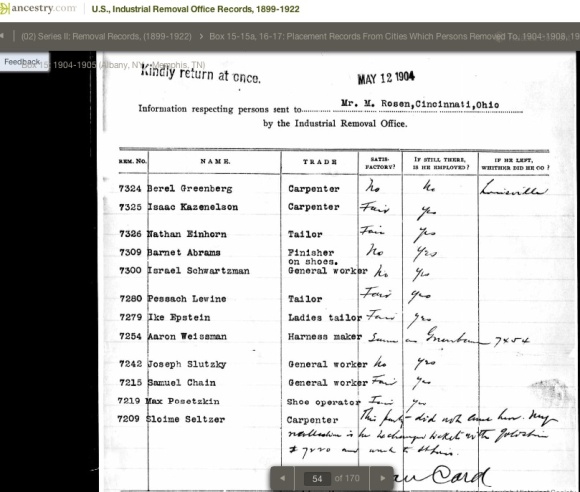
Report from the Cincinnati IRO agent on Nathan Einhorn’s relocation
Nathan and Sonia Einhorn Opened Their Home
Without their Tante Sonia and “Uncle Einhorn,” as they called him, my Bubba and much of her family might never have come to Cincinnati. Having a place to go was essential to their immigration. Nachum and Sonia provided that place. Here are are some of the records I have found:
- Idel Einhorn, age 29, male, married, tailor, arrived at Ellis Island on the SS Main on 24 Feb 1906. His destination: brother N Einhorn, 1515 John St, Cincinnati, OH. (This would be Adolph (Eidel) Einhorn.)
- Minnie Einhorn/”Eingorn,” age 29, arrived at Baltimore in August, 1906, with three young children (Jankel, age 4, Schmuel, age 3, and an infant girl whose name I can’t read). She was going to her husband, Edel Einhorn, 1515 John St., Cincinnati (Nachum and Sonia’s place).
- Leie Einhorn, age 20, married, arrived at Ellis Island on the SS Breslau on 7 Apr 1907, going to: husband, Jakob Einhorn, 1515 John St, Cincinnati, OH (so Jacob, Nachum’s brother, was living with him. Jacob had arrived in October, 1906).
- Feidel Gertzman (my great-uncle Freddie), age 23, single, a tailor, from Ekaterinolav [not really – he was from Mogilev, but that’s another story], arrived at Ellis Island 25 July 1909. He was going to his cousin, Nachum Einhorn, 1402 John St., Cincinnati (Sonia and Nathan had moved down the street).
- Avram Schlioma Gerzman (my great-uncle Sam), age 24, single, a tailor, born in Mogilev but last residing in Simferopol, arrived at Ellis Island in August, 1912 on the SS Russia. He was going to his brother at 1402 John St., Cincinnati.
- 1910 Census (April, 1910) the Einhorn household consisted of Nathan & Sarah (Sonia) Einhorn (mis-recorded as “Einhart”, and Fred and Eva Gertzman (mis-recorded as “Getzman”) at 1402 John Street. Eva Gertzman was Fred’s sister, my great-aunt.
- Sora-Rivka and Chasja Gertzman arrived at Ellis Island in June, 1913 on the S.S. Russia. This is my great-grandmother and my grandmother. They were going to Sora-Rivka’s son (Hasha’s brother), F. Gertzman at 1402 John St. in Cincinnati. So Freddie had been living with Sonia and Nachum for almost four years at this point.
- By the 1920 Census, Sonia and Nachum were still living at 1402 John Street, but no relatives were living with them.
I do not know if Sonia and Nachum provided any financial help to my family, but it is clear that, in addition to housing many of Nachum’s relatives, they housed my maternal ancestors for many years. My great-grandmother, Sora-Rivka, had four living children, and all of them lived in the apartment on John Street. Yes, it was a rented apartment. The building no longer exists.
Hints that their generosity extended beyond opening their home
I’ve heard a few snippets from relatives that tell me that Sonia and Nachum led a life of generosity to family. The née Gertzman sisters – Lil, Ida, and Ann – Freddie’s daughters, my mother’s first cousins – each spoke of memorable and frequent trips to visit the Einhorns for Shabbos dinner. Sonia was reportedly an excellent challah baker, among other things. Lil waxed ecstatic over Sonia’s many talents, including being a fine seamstress alongside Nathan’s pantsmaking business. When I had a chance to hear stories from Lil, she told me of Sonia’s intelligence, talents, and generosity. One story Lil told me involved Sonia’s rescue of an ill African-American girl. At the time Lil told me the story, she was, as I mentioned above, quite elderly and occasionally a bit confused. Although “sharp as a tack” is the cliche I’d generally use to describe her, Lil told me that this girl was a runaway slave – impossible, given the timing being about 1920. Nonetheless, I believe Lil was remembering an actual event, but just confused some of the circumstances. Lil remembered Sonia taking in this sick child, calling in a doctor to diagnose and treat her, and then nursing the child back to health. One cousin on my Gertzman side, a granddaughter of Harry Gertzman, wrote me the following recollection: “Now I do recall that Harry had a sister named Sarah, and I also recall Uncle Einhorn. I believe that he’s the uncle who gave my dad a gold monogramed ring for his bar mitzvah {which was at age 12 rather than 13 because now he was now the man of the family!} I have the ring and wear it every day. It will eventually go to my grandson, Sam, who was named after my dad.”
“Don’t Bother Mine Pants”
In my family we have a phrase meaning, “Don’t bug me!” It goes, “Don’t bother mine pants!” or, as my mother used to say, “Don’t bodder mine-a pants!” This is an inadvertent present handed down from Uncle Einhorn. He was a pantsmaker. As I gathered from Lil and Ann and Ida, he had his business in his home. If someone spoke to him or tried to get his attention when he was sewing, he would say, “Don’t bodder mine-a pants!” meaning, don’t bug me when I’m working on pants.
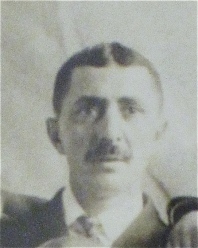
Uncle Einhorn
A Poignant Plea for a Son, 1911
In 1911 Sonia would have been in her upper thirties, having been born in the early 1870s. She and Nathan were childless. I have found no records of births or stillbirths to Sonia (though early records from Cincinnati are spotty). Nathan’s father, a respected patriarch, Moses Einhorn died at shul on Shabbos in February 1911. The Cincinnati Post published two articles after the funeral, one of them on the front page, focusing on Nathan and Sonia. The articles are poignant, crossing the border into the melodramatic, describing Sonia and Nathan’s desperate pleas that they might be blessed with a son. (The first article is shown in two pieces and has some overlap of text; sorry!)
Date: Tuesday, February 21, 1911
Paper: Cincinnati Post (Cincinnati, OH)
Page: 1
This entire product and/or portions thereof are copyrighted by NewsBank and/or the American Antiquarian Society. 2004.
Then again,
Date: Thursday, February 23, 1911
Paper: Cincinnati Post (Cincinnati, OH)
Page: 4
This entire product and/or portions thereof are copyrighted by NewsBank and/or the American Antiquarian Society. 2004.
The Later Years – 1920s – 1940
Although Fred Gertzman’s family often visited the Einhorn home for Shabbos dinner, my own mother’s family, children of Hasha (Gertzman) and Alex Simon, apparently did not go, or did not go often. Ida sometimes told me this, wondering why the Simons did not also attend the Shabbos dinners. She wondered if it was because Alex was a less social, more a “keep to himself” sort of person. She also wondered if he did not give Hasha the money she would need for carfare to travel from Price Hill and, later, the West End. As I muse on this, I can also imagine that the money just wasn’t available, especially as the Depression hit the Simons hard. Another possibility is that Alex and his family avoided taking the streetcar because it was Shabbos. This is little more than idle speculation.
The Alex Simon family lived in Price Hill, while the Einhorns lived downtown until sometime in the 1920s. At some point in the 1920s, probably late in the decade, the Einhorns moved to Avondale. So getting to Shabbos dinner would have required taking the streetcars for my mother’s family.
In the 1930 the Census Nathan and Sonia were listed as living in a 4-family building at 332 Rockdale Ave. in Avondale. The 1929 Cincinnati City Directory listed that same address for Nathan. Earlier years in the 1920s, the Directory gave a work address downtown for him, so I’m not sure when they moved there. The Jews of Cincinnati were generally moving away from downtown and Price Hill, and into Avondale. At the time of that 1930 Census, Nathan was listed as the owner of that building, valued at $12,500. However, something is confusing here because another person in the same building is also listed as owner, value $18,000.
The listing gives Sonia’s age as 56 and Nathan’s as 57 years old, occupation Pants Maker in the tailoring industry, but not the owner of his business. The 1930 census also asked if the individual was at work the last working day prior to the census and, for Nathan, the answer was “no.” It then referenced line 9 on the Unemployment Schedule (and I need to find out if that is able to be accessed online or elsewhere).
The Depression hit everyone hard and, one can imagine, an aging, old-fashioned pants maker might lose his work. I don’t know how long Nachum was unemployed. The first indication I have that he eventually found employment was in the 1933/34 Cincinnati Directory that listed him as a “clothes presser 3482 Burnet Av”; no longer tailoring, but still working. The home address was still 332 Rockdale.
In the 1940 Census Nathan and Sonia are shown as still living at 332 Rockdale. This time only Nachum shows as the building’s owner, but the value had dropped to $3,000. Again Nachum, now age 67, was out of work but was seeking work. The number of weeks out of work was listed as 520 (10 years), which seems unlikely given he was working as a presser in the mid-1930s. His “number of weeks worked” in the previous year was zero. Both Nathan and Sonia were noted to have other source(s) of income. Certainly the rent they were receiving would be one of those. They also had a lodger living in their unit, Sydney Goldman, age 23, a salesclerk in a pawn shop.
So where is that Rockdale Avenue home now? Gone. It is an empty lot. According to a search I just did, it last sold in 2005 for $8,300.
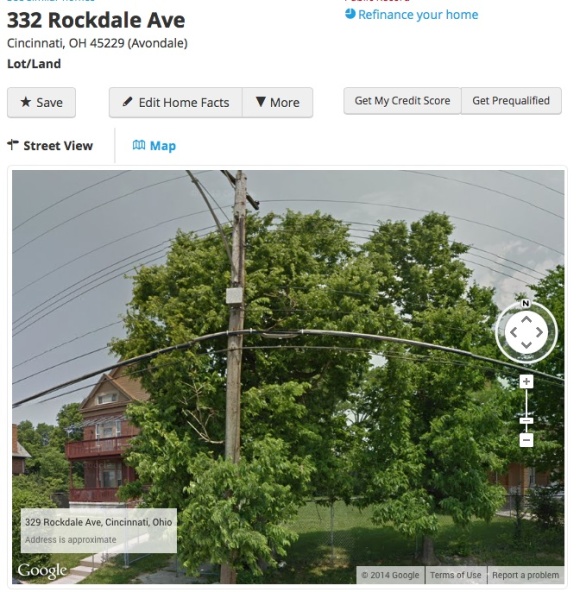
More About Sonia in her Later Years
The 1940 Census had a unique feature – it gathered supplementary information for two people on each census sheet. Sarah was selected on hers. However not much additional is revealed. It says that she was from “Russia”; that she was married only once; and that she was age 20 when first married. But there is something really odd here. In the column for number of children ever born, not including stillbirths, the number is “one”. Did Sarah ever have a child, perhaps one that died very young? The 1910 Census, when she was shown as 36 years old, said she had had “zero” children born. Although I have just repeated searches for record of a birth or death of a child of Sonia and Nachum, I’ve not found a trace.
In her later years it seems to me that Sonia did not have much interaction with my mother’s family, nor with the Fred Gertzman family. Lil Gertzman spoke of being close with her Aunt Sonia, but she didn’t relate specific stories about her, except in the years Lil was a young girl. In 1930 Lil turned 15. I also heard nothing specific about her, in her later years, from Ida or Ann. They both mentioned Shabbos dinners, but nothing more than that.
It seems to me Sonia and Nachum may have had more connection with another branch of my family, the family of Harry and Sarah Gertzman. I knew almost nothing about this branch until I began researching family history.
Harry Gertzman was Sonia Einhorn’s brother, as was my great-grandfather, Nachum Gertzman. This gets confusing to read about, because it seems that almost everyone was named Sarah or Nachum.
Harry Gertzman died young, at about age 40, in 1913 of tuberculosis. He left his widow, Sarah (nee Billipinsky), with seven children ranging in age from about one year old to about fourteen.
Descendents of Harry and Sarah Gertzman have sent me scans of photos including Sonia (“Aunt Einhorn”) and Nachum (“Uncle Einhorn”). The individual portraits I have above, earlier in this post, are cropped from these scans. Here are others:
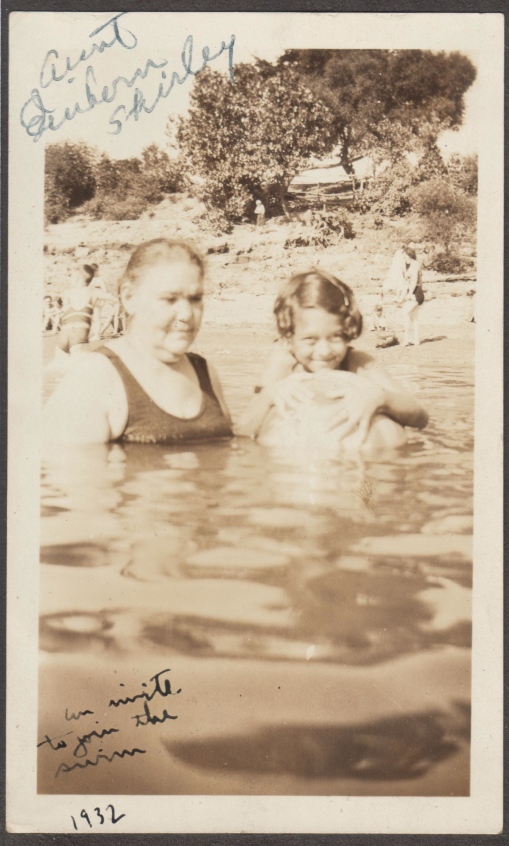
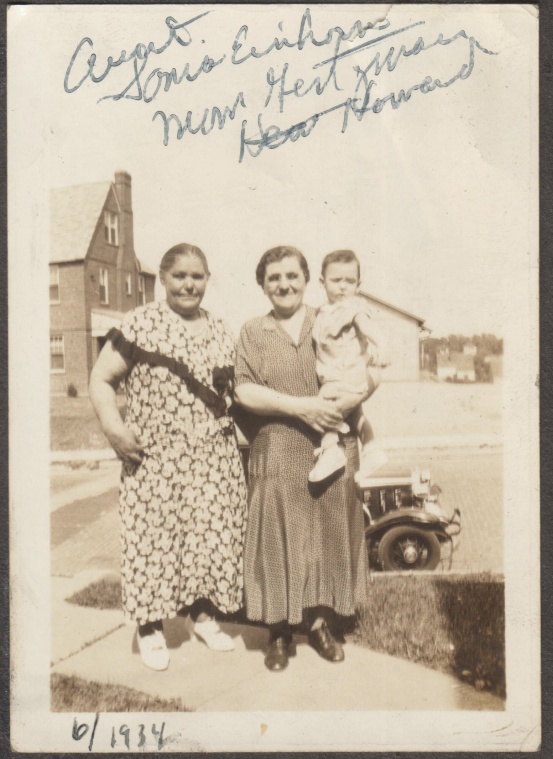
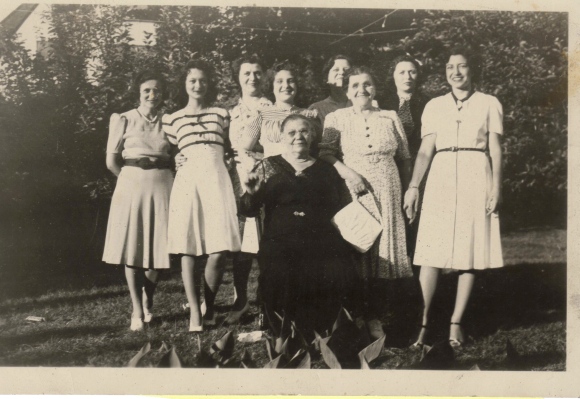
Deaths in the Early 1940s
Sonia died December 26, 1942 at about 70 years of age. Here is her death certificate.
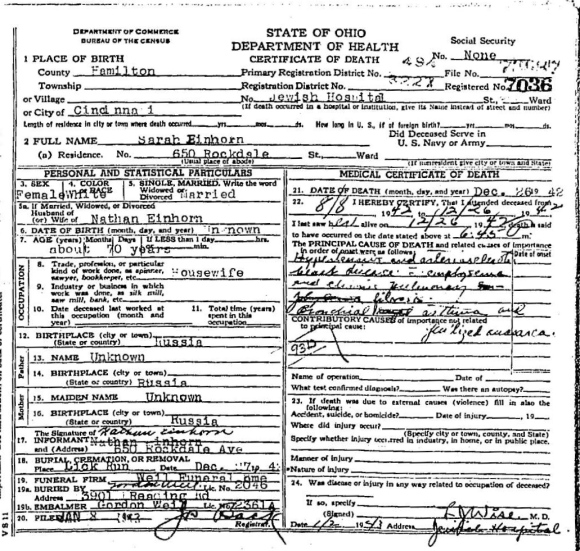
It looks as if she died of heart disease. She clearly had cardio-pulmonary disease, perhaps chronic heart failure, as my grandmother, Hasha, did. (Hasha was her niece.) Nathan was the informant on the death certificate and he certainly gave little information about his deceased wife.
I note parenthetically that the Einhorn’s address had changed to 650 Rockdale Avenue. That address appears to be non-existent now.
Nachum died less than two years later, on August 10, 1944, age 73 according to Aaron, one of his younger brothers. According to Aaron, Nathan was 73 years old when he died.
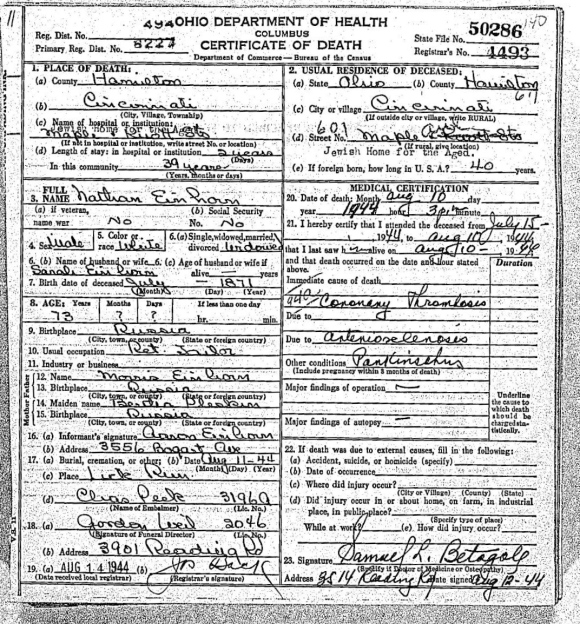
The death certificate indicates that Nathan was living in the Jewish Home for the Aged (on Maple in Avondale) and had been living there for two years. So, probably, he moved there shortly after Sonia’s death.
Here is a photo of their headstone, in the Love Brothers Cemetery in Cincinnati.
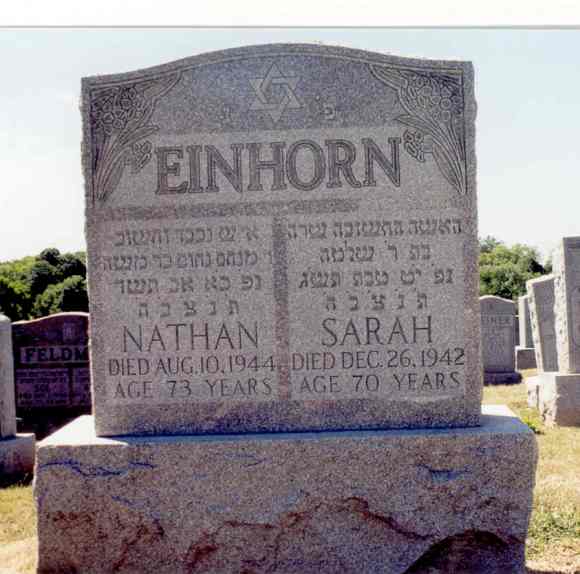
The Hebrew on Nathan’s side says: A Respected and Important Man, Reb (Mr.) Menachem Nachum Son of Moshe, Passed 27th Day of the Hebrew Month of Av in the Hebrew Year 5704. The last line is the usual quotation from Samuel – May his soul be bound up in the bond of eternal life.
The Hebrew on Sarah’s side says: An Important Woman, Sarah Daughter of Reb Shlomo, Passed: 19th day of the Hebrew Month of Tevet in the Hebrew Year 5703. The last line is also the Samuel quotation.

